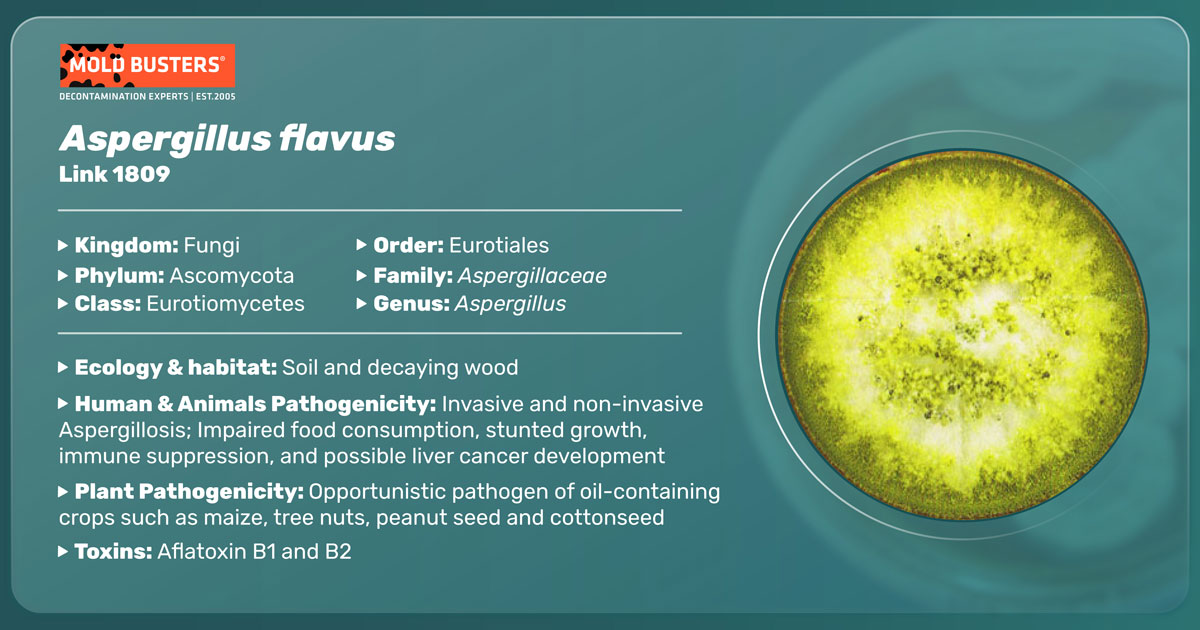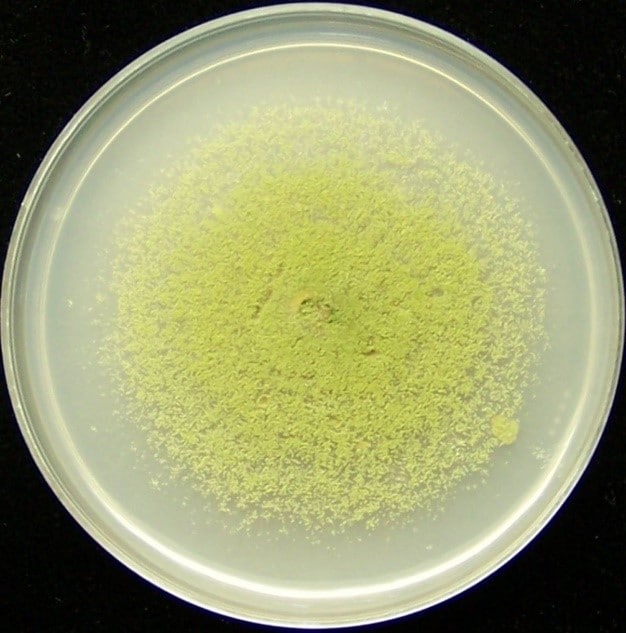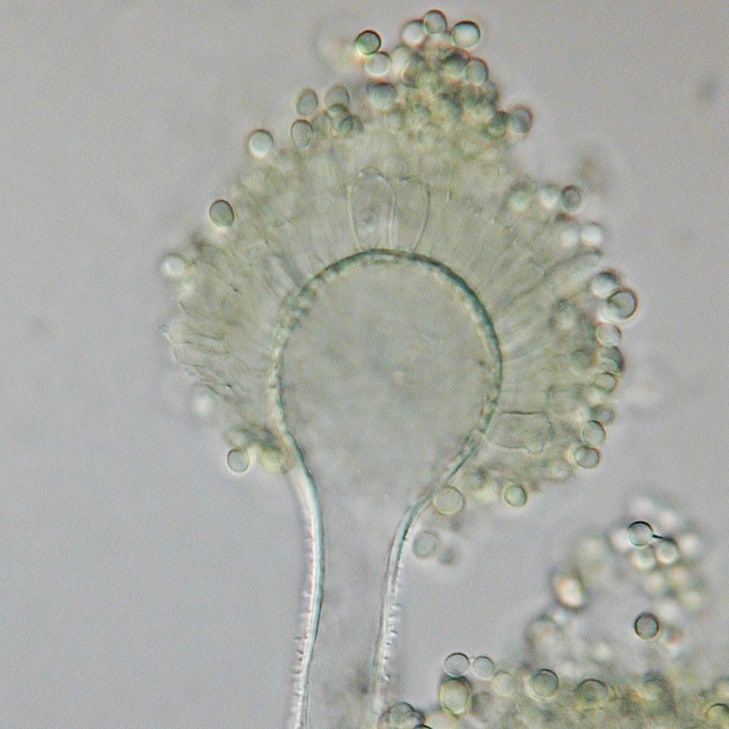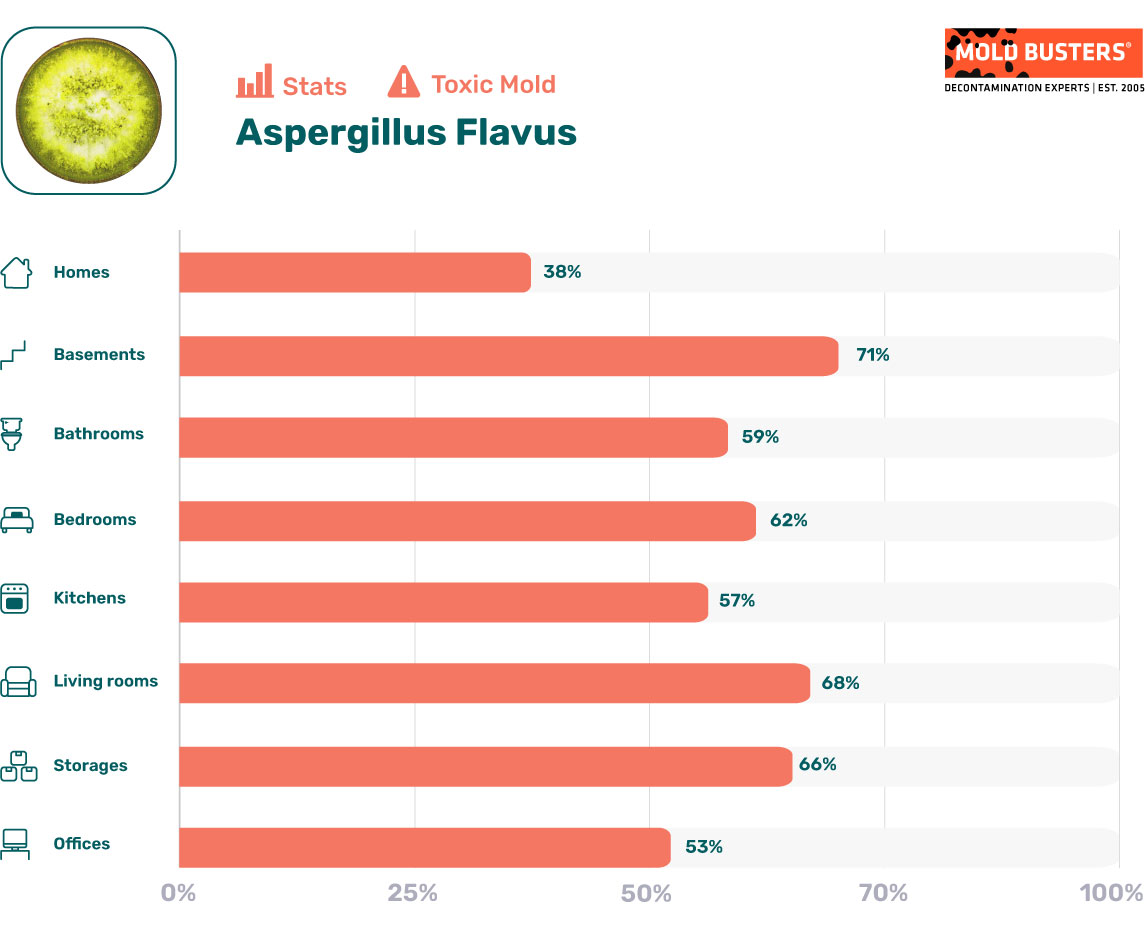Link 1809
What is Aspergillus flavus mold?
Aspergillus flavus is a saprophytic and plant-pathogenic mold fungus with a worldwide distribution. A. flavus is also a plant pathogen, well known for being able or preharvest, postharvest, and storage infections.
A. flavus crop infections can lead to yield losses that have been reported to be worth millions of dollars. This species can deal significant damages to crops such as grains, tree nuts, and legumes. A. flavus releases several mycotoxins, which can have serious adverse health effects [2].

Aspergillus flavus morphology
Aspergillus flavus colonies are usually up to 70 µm in diameter, velvety at margins, and tufted in the center. The color of the cultures ranges from whitish, gray, yellow-green or olive-yellow, and sometimes pure yellow.

Some isolates produce sclerotia, which are structures that help the organism survive harsher conditions, such as overwintering. They are initially white but become reddish-brown to black when hardened and mature. Sclerotia are spherical, usually between 400–800 µm in diameter. Conidia (asexual spores) are formed on metulae and phialides. They are spherical to subspheroidal, 3.5–5.0 µm in diameter, often yellowish, with thin-walled, and mostly roughened, rarely smooth [7].

Aspergillus flavus toxicity
Aspergillus flavus is one of the major sources of aflatoxins, which are among the most concerning toxins in food production. Four naturally produced major aflatoxins are B1, B2, G1, and G2. “B” and “G” aflatoxins get their name by the blue and green fluorescent colors which are produced by the toxins under UV light. The numbers 1 and 2 represent certain major and minor compounds contained by the toxins. Aflatoxins are toxic to all mammals, including humans. The poisoning usually occurs through ingestion of infected grain, or through the consumption of dairy and meat products, contaminated through animal feed infected by Aspergillus sp. Ingested, aflatoxins can cause cancer (carcinogenic), alter DNA (mutagenic), disturb embryo development (teratogenic), damage our liver and kidneys (hepatotoxic and nephrotoxic), and repress our immune system (immunosuppressive) [7].
Aside from aflatoxins, A. flavus produces cyclopiazonic acid, which can contribute to the degeneration and necrosis of various organs, but has low oral toxicity [3]. Aflatoxin contamination is a major problem in developing countries. Contaminated maize has been responsible for the death of hundreds of people in Kenya in recent years, and its use in dog foods has killed over 100 dogs in the United States in 1998 and 2005-2006 [4].
Why does Aspergillus flavus produce aflatoxin?
As secondary metabolites, mycotoxins are not necessary for the growth of fungi. A possible theory is that fungi use mycotoxins to weaken their hosts and thus provide an environment with less resistance to their development. A. flavus will produce aflatoxin if the temperature is above 15°C (59°F) and the water activity above 0.90 [7]. Aflatoxin contamination can occur pre- or post-harvest and affects many commodities, including peanuts, corn, wheat, millet, rice, sesame seeds, sunflower seeds, cotton seeds, and tree nuts.
Aflatoxins were originally discovered during the 1960s, when aflatoxin contamination caused the Turkey X outbreak which decimated this poultry species in the United Kingdom. This occurred as a peanut supply, used for poultry feed, was contaminated with A. flavus. This resulted in the death of over 100.000 turkeys and the subsequent discovery of aflatoxins [9].
Ecology of Aspergillus flavus?
Aspergillus flavus is tolerant to a wide range of temperatures and pH substrate values. Optimal growth is achieved at 33°C (91°F) but can withstand temperatures ranging between 10–48°C (50–118°F). Like most molds, it requires moisture to grow. Optimal water activity (aw) of the substrate will depend on temperature, with minimal values at aw=0.78. Similarly, it shows a wide tolerance for pH values, ranging from 2.1–11.2, with optimal growth achieved at 7.5 [5].
Where does Aspergillus flavus mold appear in the house?
Although this pathogenic mold is usually found outdoors on dead plants and animals, it is often found indoors. The most common place to find A. flavus is on carpets, as the carpet texture is excellent at catching and holding mold spores. Colonies of A. flavus will exploit any excess moisture found in an average household. Thus, high humidity spaces such as basements, kitchens, cellars, and bathrooms are areas where you may expect to find mold colonies.
The Environmental Relative Moldiness Index (ERMI) is an indoor air quality testing method developed by the U.S. Environmental Protection Agency and the U.S. Department of Housing and Urban Development. A. flavus is one of the ten Aspergillus species tested for. ERMI was designed as a reliable standardized method to evaluate air quality and mold contamination of households. It uses DNA-based technology to assess which adverse mold species, connected with water damage, and assigns a value to their quantity. Apart from being toxic due to ingestion, prolonged exposure to these mold spores can have various adverse health problems, ranging only from respiratory irritations and allergens to more serious conditions such as invasive aspergillosis, pneumonia, and asthma.
Aspergillus flavus mold statistics
As part of the data analysis presented inside our mold statistics resource page, we have calculated how often mold spore types appear in different parts of the indoor environment when mold levels are elevated. Below are the stats for Aspergillus flavus:


Symptoms and health effects of Aspergillus flavus
Most human A. flavus infections are the result of the inhalation of fungal spores by immunocompromised individuals. In most cases, the immune system quickly deals with these unwanted foreign bodies, but immunocompromised individuals or those with underlying pulmonary or immunity issues can develop more serious complications.
The collective name for these Aspergillus spp. infections is aspergillosis. Depending on the individual case, symptoms can include:
- Fever and chills
- Coughing up blood
- Wheezing or shortness of breath
- Chest or joint pain
- Headaches
- Eye symptoms
In susceptible individuals, aspergillosis can cause arthritis [6], which can be manifested with fever, pain, swelling, joint tenderness, and restricted range of motion. Antifungal agents can aid in treating this condition, although severe cases may call for surgery.
Adverse health effect of A. flavus related to aflatoxin poisoning is regarded as aflatoxicosis. Acute exposure can cause nausea, vomiting, abdominal pain, convulsions, pulmonary and cerebral edemas, severe liver damage, and ultimately death.
What disease and infection does Aspergillus flavus cause?
In humans, A. flavus spores cause aspergillosis. This is an infection that starts with the germination of inhaled spores. Most often it develops in the respiratory system, however, hyphal fragments may separate and travel through the bloodstream and cause a systemic infection. People with weak immune systems are the most and easily affected group.
People possessing a healthy immune system may only suffer from a mild allergic reaction, due to long-term exposure to mold spores. In rare and extreme cases, systemic aspergillosis can result when the infection is left unchecked and manages to spread to the circulatory system, lungs, brain, skin, and beyond. Fever, coughing blood, wheezing, fatigue, and severe asthma are the common symptoms of this infection. Severe cases of aspergillosis are life-threatening.
How to prevent and remove Aspergillus flavus?
Mold Busters is a company that provides professional mold remediation services for toxic molds. We are the leaders in this industry, utilizing the latest technologies and most advanced equipment. Our certified mold technicians are experts in removing Aspergillus flavus mold (and many others) from all parts of your home or office. This can save your life as well as the lives of your loved ones.
We offer affordable services that will effectively eliminate Aspergillus flavus from your home, including air duct cleaning, odor removal, dehumidification and moisture control, testing for and removing mold, mold-proofing basements, infrared inspections, and antimicrobial treatments. Our objective is to ensure the quality of life through quality of service. Call us today to book your appointment.
References
- Jariwal R, Heidari A, Sandhu A, Patel J, Shoaepour K, Natarajan P, Cobos E (2018). Granulomatous Invasive Aspergillus flavus Infection Involving the Nasal Sinuses and Brain. J Investig Med High Impact Case Rep. 6:2324709618770473.
- Rubens J, Cardwell KF. 2005. The cost of mycotoxin management in the United States. See Ref. 1, pp 1-13
- Hocking AD (2001). Toxigenic Aspergillus species. In Food Microbiology – Fundamentals and Frontiers, 2nd edition, American Society for Microbiology, Washington DC, pp. 451–465.
Amaike S, Keller NP (2011). Aspergillus flavus. Annu Rev Phytopathol 49:107-33. - Pitt JI, Hocking AD (2009). Aspergillus and Related Teleomorphs. In: Fungi and Food Spoilage. Springer, Boston, MA, pp 467-468
- Gamaletsou MN, Rammaert B, Bueno MA, Sipsas NV, Moriyama B, Kontoyiannis DP, Roilides E, Zeller V, Taj-Aldeen SJ, Henry M, Petraitis V, Denning DW, Lortholary O, Walsh TJ; International Osteoarticular Mycoses Consortium (2017). Aspergillus arthritis: analysis of clinical manifestations, diagnosis, and treatment of 31 reported cases. Med Mycol 55(3):246-254.
- Peromingo B, Rodríguez A, Bernáldez V, Delgado J, Rodríguez M (2016). Effect of temperature and water activity on growth and aflatoxin production by Aspergillus flavus and Aspergillus parasiticus on cured meat model systems. Meat Sci 122:76-83.
- Pitt, J. I., & Hocking, A. D. (2009). The ecology of fungal food spoilage. In Fungi and food spoilage (pp. 3-9). Springer, Boston, MA.
- Amare, M. G., & Keller, N. P. (2014). Molecular mechanisms of Aspergillus flavus secondary metabolism and development. Fungal Genetics and Biology, 66, 11-18.

Get Special Gift: Industry-Standard Mold Removal Guidelines
Download the industry-standard guidelines that Mold Busters use in their own mold removal services, including news, tips and special offers:

Written by:
John Ward
Account Executive
Mold Busters
Edited by:
Dusan Sadikovic
Mycologist – MSc, PhD
Mold Busters
